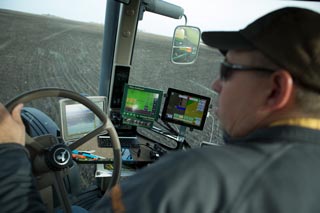Making Data-Driven Decisions For Your Operation
Sep 01, 2020

Wesley Hedges
Precision Ag Manager
Data-driven, as defined by the Oxford English Dictionary, means “determined by or dependent on the collection or analysis of data.” In other words, decisions are made with help from data numbers as opposed to intuition alone. Data-driven decisions can increase confidence in decision-making, identify savings, and improve efficiency. Let’s look at some examples of how we can use data in farming to help make decisions.
ProFarm
ProFarm is a Farmers Cooperative precision agronomy program used to help farmers make data-driven decisions. ProFarm helps to set yield goals for every field, every zone within each field, on every crop type. Setting yield goals to this extent allows for benchmarking against the following years and making recommendations based on the data. Since yield data is recorded every year, a summary of the results (report card) is provided yearly, thus allowing for analysis and adjustments of future recommendations. Utilization of yield data is a big part of starting down the road to making more data-driven decisions on the farm.
Soil Sampling
Soil sampling is an excellent source of data that can be interpreted to determine underlying yield limiting issues. However, it is important to choose the right soil sampling method, whether that be grid, zone or composite, as it affects the nutrient variability that is revealed. The data from the soil samples can then be converted into fertility recommendations that can be variably applied to correct low fertility levels. Furthermore, soil sampling data and ProFarm yield goals can be combined to provide fertility recommendations that correct low fertility levels while also considering the varying spatial nutrient removal.
Imagery
Imagery is another source of data that can be used in the decision-making process both in-season and during the off-season. Common in-season uses of imagery includes on-demand variable rate nitrogen prescriptions, directed sampling, and scouting. While in the off-season, the imagery can be used to develop management zones for farmers without yield data. There are two forms of imagery we offer: satellite and drone. Which source we decide to use will depend on the farmer’s objectives and goals, and in some cases, they tend to complement each other.
In-Field Hardware Systems
Lastly, in-field hardware stations for measuring things like weather conditions and soil moisture is another useful source of data. These in-field hardware stations can be placed essentially anywhere and are then connected to the internet so the data measurements can be viewed remotely. These in-field hardware stations can save time and money by eliminating the need to physically travel to that location since the measurements can be viewed from a smartphone anytime, anywhere.
We have more data at our fingertips today than ever before. Determining what data is most valuable to you and your operation is certainly a start. However, the key is to put this data to work for you and your bottom line.